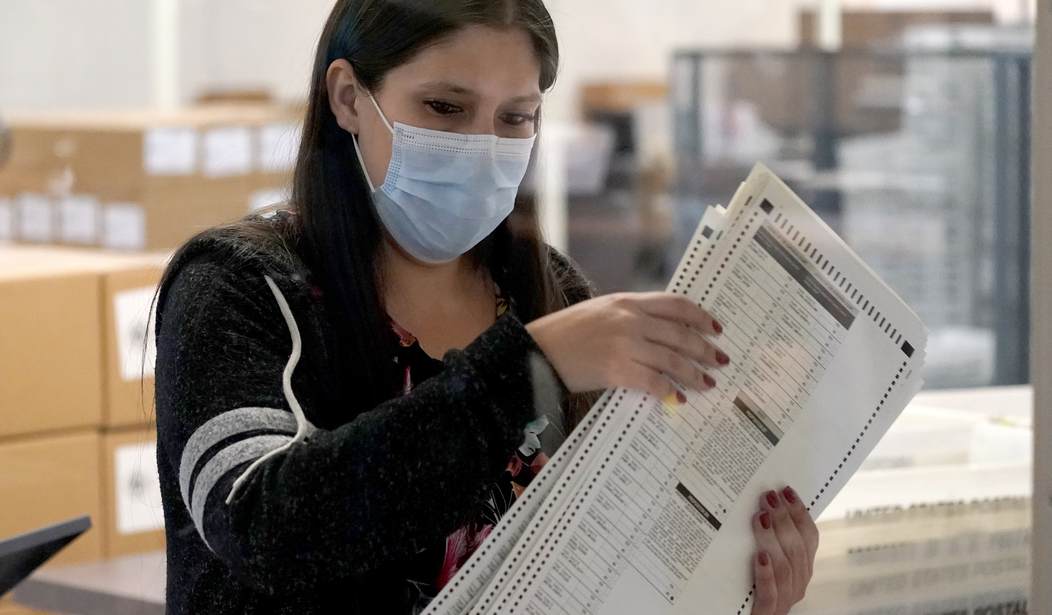The mainstream media was quick to jump on the leaked draft report of the Maricopa Country 2020 election audit, claiming (falsely) that it proved Joe Biden was the legitimate winner of Arizona.
It did no such thing. Like the hand recounts before it, the hand recount conducted by the audit team found few discrepancies in the vote tallies of the ballots. The forensic audit, however, did uncover 57,734 ballots impacted by irregularities—which is 5.5 times Biden’s state-certified margin of victory of 10,457 votes. The audit team acknowledged that “in many cases there could be legitimate and legal votes within the Ballots Impact amount,” but without vetting these votes, we’ll never know. The results of the election can’t be changed at this point, but the audit team did make a number of suggestions for legislative fixes to make Arizona’s elections more secure.
Sadly, the mainstream media used the hand recount results to declare that Biden was confirmed the winner, even though the audit identified over 57,000 votes impacted by irregularities, and stated unequivocally that “full audit results validating the 2020 General Election are necessarily inconclusive.”
I am under no illusions. We’ll never get a proper vetting of these questionable ballots. But one thing is clear: There were a lot of irregularities, and those irregularities impacted enough votes that they could have altered the results of the election. Below, I will explain the findings of the medium, high, and critical ballots—which account for 53,214 of the 57,734 ballots impacted, so you can understand why they were flagged by the audit team, and why a significant number of these ballots could be fraudulent.
Mail-In Ballots Voted From Prior Address (23,344)
“Mail-in ballots were cast under voter registration IDs for people that should not have received their ballots by mail because they had moved, and no one with the same last name remained at the address,” the audit found. This is significant because “Mail-in ballots are, by Arizona law A.R.S. § 16-558.01, never forwarded.”
“If a registered voter does not have a secondary mailing address listed with the county and no longer lives at the address listed on their voter registration, they should not receive their mail-in ballot,” the report explains, but notes that it “may be possible for them to receive a ballot, for example, if they know the present occupant, or if the ballot is improperly forwarded.”
Obviously, there’s a lot of potential for fraud there.
Related: Ignore the MSM: Here’s What the 2020 Maricopa County Election Audit Actually Says
Potential Voters Who Voted in Multiple Counties (10,342)
The audit team compared the Maricopa County “Final Voted File” (VM55) to the equivalent files from the other counties in the state, and found 10,342 voters with the same first, middle, surname, as well as birth year. “While it is possible for multiple individuals to share all these details; it is not common, and this list should be fully reviewed.”
These votes potentially mean that there were duplicate voters within one county or between different counties.
More Ballots Returned by Voters Than Received (9,041)
Based on examination of the Early Voting Returns File (EV33) and the Early Voting Sent File (EV32), there were 9,041 instances of a voter being sent one ballot, but two ballots were returned and received on different dates. There are a number of situations that could explain this. First, more than one ballot could have been sent out, but the entry was not logged in the EV32 file. It’s also possible the same ballot could have been processed more than once on different days, creating two EV33s for the same ballot. Neither of these cases would necessarily be fraudulent. However, it is also possible that an individual could have voted early by mail-in ballot, and also voted early in person. There’s also the possibility that “a fraudulent ballot was sent via mail and both the legitimate ballot sent and the fraudulent ballot generated EV33 entries.”
Whatever the reason, be it accidental or fraudulent, there’s a problem here.
Official Results Do Not Match Who Voted (3,432)
According to the official results for Maricopa County, there were 1,915,487 early votes, and 174,076 Election Day votes, for a total of 2,089,563 votes. But, according to the Final Voted File (VM55), there were actually 1,912,093 early votes, and 174,038 Election Day votes, totaling 2,086,131. The delta for the early votes is 3,394, and the delta for Election Day votes is 38, for a total difference of 3,432 votes. These numbers are significant as it’s clear from the numbers that early votes account for 98.89 percent of the discrepancy. At the very least, this proves that mail-in voting isn’t as secure as in-person voting.
More Duplicates Than Original Ballots (2,592)
The audit found that Maricopa County reported “27,869 duplicate ballots pertaining to the Presidential Electors,” yet the audit team counted 29,557 duplicate ballots. “However, only 26,965 original ballots that were sent to duplication.” Ballot duplication is an automated process to transcribe ballots that are damaged or unreadable by the vote-counting machines.
“A comparison of the total number of original ballots sent to duplication vs the total number of duplicate ballots shows that Maricopa County counted 2,592 more duplicate ballots than original ballots sent to duplication,” the report says. “The audit team attempted to resolve the discrepancies, but those efforts were impeded by the County’s failure to properly identify duplicate ballot batches and failure to assign unique serial numbers to each damaged ballot sent to duplication and then match that number to the duplicate ballot printed to replace it.”
In-Person Voters Who Had Moved Out of Maricopa County (2,382)
The audit team cross-checked the Final Voted File and determined that “2,382 ballots were cast voter IDs for individuals that moved outside of Maricopa County prior to 10/5/2020,” which is outside the 29-day window in which voters are still eligible to vote in their original county of residence.
Voters Moved Out of State During 29-Day Period Proceeding Election (2,081)
According to Arizona law, anyone who moves out of state within 29 days before the election is no longer considered a resident, but can (for some reason) still vote for president on a presidential-only ballot. The Final Voted File was cross-checked against data of residents who have moved or died, and the cross-check “resulted in 2,081 instances of a voter that moved out of the state of Arizona during the 29-day period before the election who cast a ballot in the 2020 general election.”
Why does this matter? “The ballot definitions on the Dominion EMS do not include a ‘Presidential-Only’ ballot,” the audit report explains. “The Dominion voting machines would not be able to read a ballot for which a ballot definition does not exist. Additionally, in examining the EV33 sent ballot files for ballot codes, the ballot images, and the cast vote record, no presidential-only ballots as specified by A.R.S. § 16-126 and the 2019 Election Procedures Manual were found to be cast in this election.”
Conclusion
The flagged ballots above, plus the 4,520 low-severity ballots not detailed, give us plenty of reason to question the official results of the election in Arizona given the small margin of victory. The MSM’s deliberate misrepresentation of the audit’s findings prove they know these are serious irregularities that may have changed the results of the election. In other words, the audit didn’t confirm Biden’s victory. There were significant irregularities, and those irregularities impacted five times the number of ballots than Biden’s certified margin of victory. While fraud may not have been proven yet, and we may never know if a vetting of these impacted ballots prove Trump legitimately won Arizona, the audit, nevertheless, vindicates Donald Trump.










